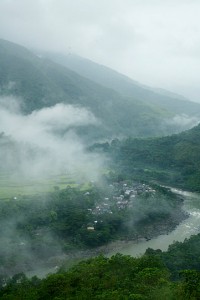 On Sunday morning I had a choice. My stomach was feeling queasy, I had a headache, and the sore throat I’d been developing over the past couple of days started to feel suspiciously like the onset of strep.
On Sunday morning I had a choice. My stomach was feeling queasy, I had a headache, and the sore throat I’d been developing over the past couple of days started to feel suspiciously like the onset of strep.
I was in Tinglayan, deep in the heart of the remote Kalinga province, home of the headhunters of old and of the fierce mountain tribes that to this day still occasionally battle it out over territory disputes (and some of which you’re best advised not to try to visit at all, local guide or not.)
The village of Tinglayan itself is not particularly easy to get to, and my guide Francis and I were planning to spend the next few days trekking deeper into the mountains, to visit tribal villages that see neither cars nor electricity, and very few outsiders, white or otherwise.
But I felt terrible, and to top it off, it was raining, as it had been for the past week in the area. Should I rest for a day and hope for better health and weather on Monday? Pfah.
I decided to roll the dice. Popping a penicillin pill I’d bought in Bontoc, a couple tablets of ibuprofen, and two cups of hot, strong local coffee, I said let’s do this, and up into the mountain jungle we went.
November 26th,2008
Philippines |
7 Comments
November 25th,2008
Philippines |
No Comments
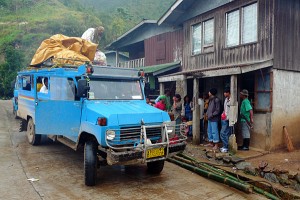
My jeepney to Tinglayan
Tonight for dinner I had steamed frog legs and carrots dipped in a blended sauce of chili, vinegar and soy, and it was delicious.
I am far off the beaten path, and about to go farther. When I told my guide in Sagada that I wanted to go trekking in Kalinga, his eyes momentarily widened and he went “ooooh.” Two days later, he slipped me a piece of paper with the name of a guide that could take me there. “Be careful,” he said.
Kalinga is headhunter country. Although the practice has mostly died out, there are still tribal battles between villages, and during the 80s there was open warfare between the tribes and President Marcos’ government, who wanted to dam up the valley for power. The tribes won.
In Bontoc, as I was sipping a Coke to help rid myself of a queasy stomach, one of the locals chatted me up. When he heard of my plan to venture north to Tinglayan and into neighboring villages, he looked concerned. “You need to go with guide,” he said. I solemnly agreed.
I inquired about the guide Francis at the police station. The police captain and one of his lieutenants personally walked me across town (given how the locals gaped, they probably thought I was under arrest), and helped me locate him. Two hours later, Francis and I were on a jeepney headed north, into some of the most remote mountain tribal areas of the Philippines.
The small, single-lane road through the mountains was muddy and bumpy, crossing streams and skirting cliffs and snaking its way north along the path of the Chico river. Several hours of bone rattling travel, but all easily ignored by the sheer lush beauty of the mountains. Hills so green they almost defied the sense of color, rich with foliage, sparkling wet from a constant light drizzle, a soft cloud cover caressing the hilltops and occasionally drifting in and out of valleys.
And at last, right before dark, the tiny little village of Tinglayan on the banks of the Chico river, as far as the road can take me in this remote territory. From here, it’s on foot the rest of the way to the tribal villages. But first, a few more frog legs for dinner.
November 25th,2008
Philippines |
4 Comments
A few shots from inside the cave:
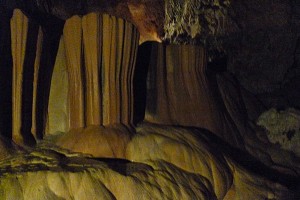
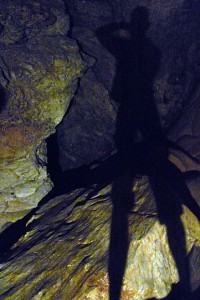
My shadow on the rocks
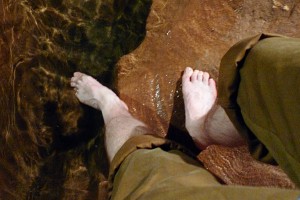
Hey, this water is cold!
November 22nd,2008
Philippines |
4 Comments
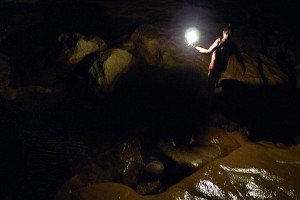
Follow me...
Bats are not quiet sleepers. Maybe if there were just a few, you wouldn’t notice so much. But pack some 10,000 bats all sleeping upside down in a dark cave, and you’ll definitely hear them. It’s a constant hum of high-pitched, symphonic screeching.
Descending into the wide opening of the cave, the lush green jungle gave way to cool, humid air. And darkness. At the edge of the light, our guide fired up a kerosene lamp, and we ventured deeper inside.
The rocks were slippery. Maybe from condensation dripping down, maybe from rainwater seeping dirt and mud in from outside, maybe from mold, maybe from bat droppings. I really don’t know, but when I felt something wet drop down onto the back of my neck, I immediately suspected the damn bats and heaved up a curse at their assembled mass.
Slipping and sliding down the rock formations, trying to see and feel my way by the dim light and myriad of shadows projected by the lone kerosene lamp, I followed the guide down deeper into the earth, ever so careful to not twist an ankle or slip and brain myself on a nearby stalagmite.
Imagine my surprise, then, when the guide stopped, turned to me and said “be careful, from here it’s slippery.” What?! Like it wasn’t slippery before?
Only he wasn’t kidding. Slippery really isn’t the right term. From that point on, let’s just say that each and every rock had been personally and very generously hand-lubricated. Friction ceased to exist. You could have wrapped yourself in heavy-duty sandpaper and still slipped around those rocks like on your backyard Slip-and-Slide. I was legitimately concerned about breaking something, and all this lurching and flailing around in the dark like that made me feel ridiculously retarded and uncoordinated.
Thankfully, the Slip-and-Slide section of the cave gave way to the take-off-your-shoes-and-go-barefoot section. Traction at last! A relief even if it meant a) slowly wearing off the layers of skin on my feet and b) cold water everywhere. But so beautiful, with little waterfalls and streams and crystal clear pools of water—some deep enough to swim in—all deep inside a dark and mysterious cavernous underworld.
On the way back to Sagada, the guide showed us some of the area’s “hanging coffins,” burial places set into cliffs according to ancient local traditions. A few years ago a couple students from Manila decided to “borrow” one of these coffins to study it. They apparently were not aware of the curse befalling those that disturb the dead: one of the two died shortly thereafter, and the other hurried to bring back the coffin to its rightful place, but our guide assured us that it’s too late for him as well. So no disturbing of coffins for me.
November 22nd,2008
Philippines |
1 Comment
A few quick shots walking around the little mountain village of Sagada:
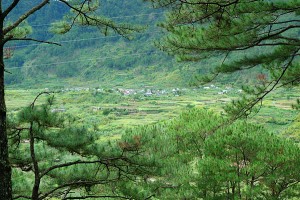
View of another village in the valley
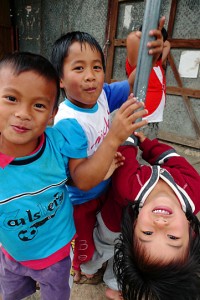
Kids having fun
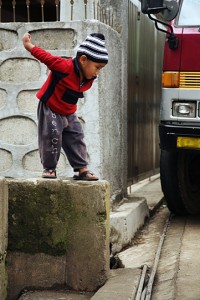
Boy about to jump
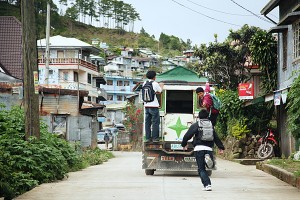
Running to catch the jeepney
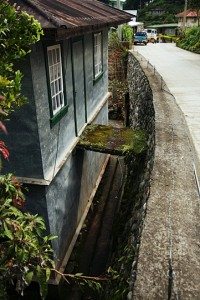
Is that a moat and drawbridge?
November 22nd,2008
Philippines |
1 Comment
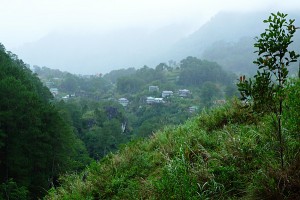
Arriving in the remote mountain village of Sagada
The overnight bus from Manila to Bontoc is not just packed with people. Oh no. God forbid there should be a single cubic centimeter of unfilled space for, say, your legs. It is also jam-packed with bags, boxes and packages. The concept of an “aisle” becomes meaningless. Everyone please sit down and now let’s see how many UPS packages we can fit in here.
The bus takes thirteen hours to reach the mountain town of Bontoc. Which in dog years translates to about two and a half weeks, and I’m going to have to wait for my butt cheeks to reincarnate to see what their take was. Another really cool feature is that you board the bus at sea level sweating up a storm, and exit in the mountains huddled inside your wool sweater and fleece—I’m sure this is a terrific progression for both health and personal hygiene.
On the map, the road to Bontoc looks like a highway. It even has a respectable highway number: 4. Using this clever numbering system, I’m going to assign a small, worn-down gravel road in Iowa the number 2.
Muddy dirt roads, switchbacks, rough going and massive drop-offs. Plus wonderfully inspiring signs helpfully written in English, such as: “One lane ahead due to road erosion.” Let me translate that for you in case a horrific visual didn’t immediately pop into your mind: that means that half the road already fell down the mountain, probably under the weight of a bus just like this one, so please drive on the other half while it’s still here and good luck.
Have I mentioned that at one point we had to wait for a couple guys to clear the road of a fallen tree with chainsaws?
On the plus side, the steep mountains and issues with erosion are also the reason for the spectacular rice field terraces of Banaue, now a UNESCO World Heritage site. We didn’t stop for pictures, but driving through some of this scenery certainly was awe-inspiring.
Which all eventually brought me to the remote mountain town of Sagada, home of the hanging coffins.
November 21st,2008
Philippines |
6 Comments
I decided to book a couple model shoots while in Manila. Here are the first images from Colleen and Myca:


Seriously. 5:48am? Feather-brains didn’t even have the decency to wait for sunrise proper. The little rascal snuck right up to my window and started bellowing “Cock-a-doodle-dooooo!” at the top of his little rooster lungs.
Worse, not too far away, rooster number two got into the act, except he had issues. He’d bellow his “Cock-a-doodle…” and you’d anticipate the “doooo,” but it never came. That really messes with your mind.
I’m having chicken for lunch.
November 21st,2008
Philippines |
5 Comments
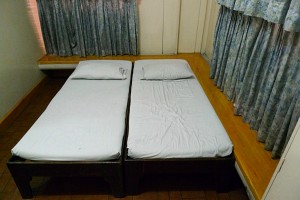
My room in Manila
By 5:00pm local time (3:00am U.S. time), my valiant efforts to fight off sleep after a 30+ hour journey came to a definitive end.
I passed out on my spartan single bed in my tiny, neon-lit un-air-conditioned room. The whirring fan overhead did little to fight the heat and humidity, so I lay in a sheen of sweat all through the evening and night, hot and likely dehydrated.
Before passing out, I had spent several hours walking around the Malate district of Manila, getting a feel for my surroundings. It’s sunny, hot, humid and extremely crowded, but a convenient place to stay downtown just a few blocks from the bay while I planned out my two weeks in country.
Although I didn’t feel particularly threatened, it doesn’t take a rocket scientist to conclude that if every shop and hotel has armed guards, many with shotguns and machine guns, some with attack dogs, all of them actively scanning the crowds of people, that Manila may be a place of occasional unrest. We’ll see.
I woke up 14 hours later, slick with sweat, and of course had the phenomenal idea that this would be a great time to work out. Wouldn’t want to get soft while I travel.
Had my mind been a little clearer, it probably should have occurred to me that the combination of extreme heat, humidity and fatigue meant I should drink up and ease into things a bit. But it didn’t.
That’s how I found myself on my knees in front of the communal toilet some time later, belatedly cursing the aggressive sets of push-ups, sit-ups, squats and shadow boxing, trying to keep my waves of nausea in check. Luckily, the toilet was immediately adjacent to the shower, so the stream of cold water on my back as I contemplated heaving up the distant remnants of my last meal probably spared me my first upchuck of the trip.
We’ll see if I handle it better tomorrow morning, hehe. But now, it’s time to explore some more.
November 17th,2008
Philippines |
2 Comments
 On Sunday morning I had a choice. My stomach was feeling queasy, I had a headache, and the sore throat I’d been developing over the past couple of days started to feel suspiciously like the onset of strep.
On Sunday morning I had a choice. My stomach was feeling queasy, I had a headache, and the sore throat I’d been developing over the past couple of days started to feel suspiciously like the onset of strep.














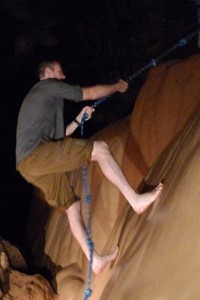
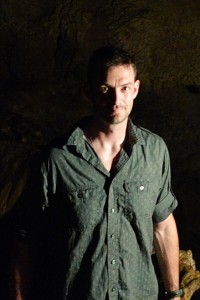
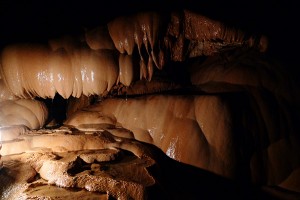










 Click to subscribe via RSS feed
Click to subscribe via RSS feed
